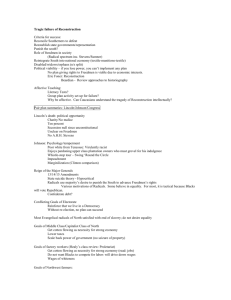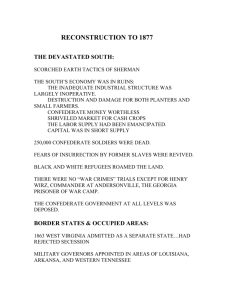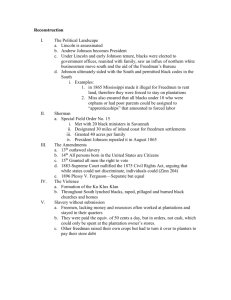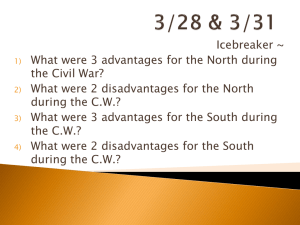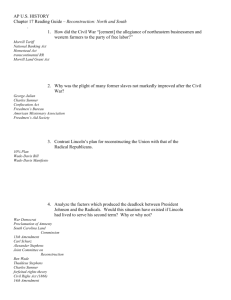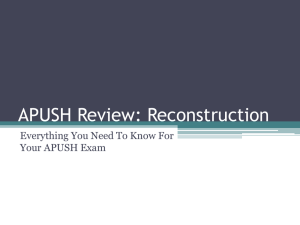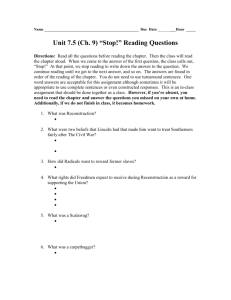Document: "With malice toward none, with charity toward all, with
advertisement
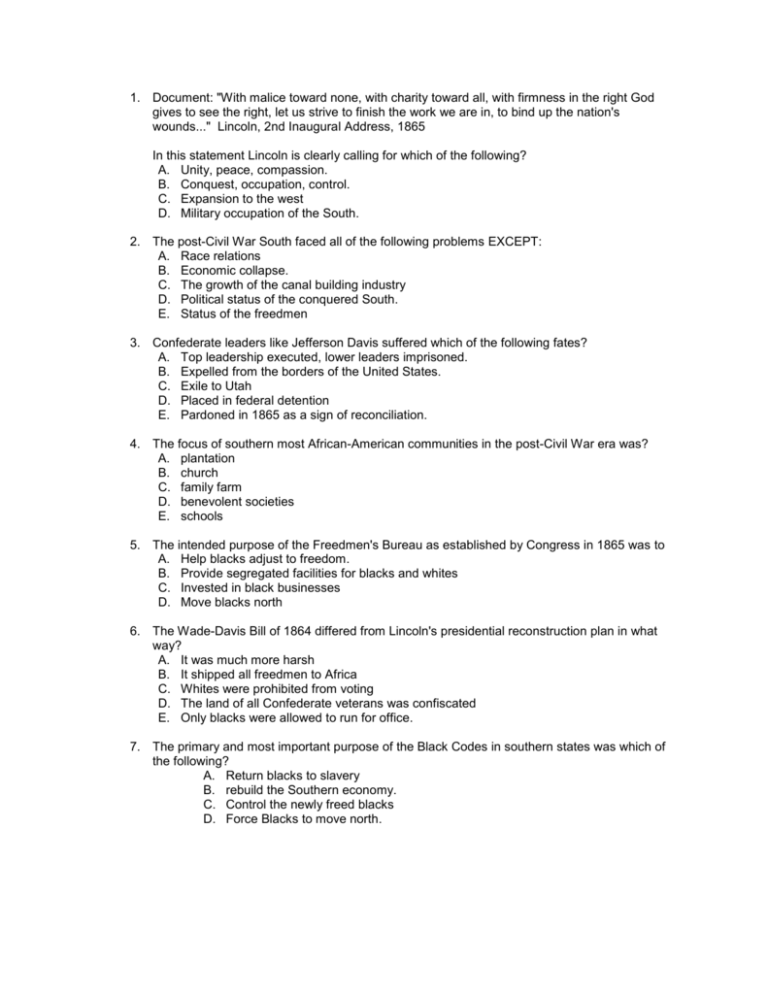
1. Document: "With malice toward none, with charity toward all, with firmness in the right God gives to see the right, let us strive to finish the work we are in, to bind up the nation's wounds..." Lincoln, 2nd Inaugural Address, 1865 In this statement Lincoln is clearly calling for which of the following? A. Unity, peace, compassion. B. Conquest, occupation, control. C. Expansion to the west D. Military occupation of the South. 2. The post-Civil War South faced all of the following problems EXCEPT: A. Race relations B. Economic collapse. C. The growth of the canal building industry D. Political status of the conquered South. E. Status of the freedmen 3. Confederate leaders like Jefferson Davis suffered which of the following fates? A. Top leadership executed, lower leaders imprisoned. B. Expelled from the borders of the United States. C. Exile to Utah D. Placed in federal detention E. Pardoned in 1865 as a sign of reconciliation. 4. The focus of southern most African-American communities in the post-Civil War era was? A. plantation B. church C. family farm D. benevolent societies E. schools 5. The intended purpose of the Freedmen's Bureau as established by Congress in 1865 was to A. Help blacks adjust to freedom. B. Provide segregated facilities for blacks and whites C. Invested in black businesses D. Move blacks north 6. The Wade-Davis Bill of 1864 differed from Lincoln's presidential reconstruction plan in what way? A. It was much more harsh B. It shipped all freedmen to Africa C. Whites were prohibited from voting D. The land of all Confederate veterans was confiscated E. Only blacks were allowed to run for office. 7. The primary and most important purpose of the Black Codes in southern states was which of the following? A. Return blacks to slavery B. rebuild the Southern economy. C. Control the newly freed blacks D. Force Blacks to move north. 8. Congress rebelled against Johnson's mild reconstruction plan to impose much harsher terms because southerners did all of the following EXCEPT? A. Passed the Black Codes in their state legislatures. B. Elected former confederate leaders to the U.S. Congress. C. Attacked Union Army units with new Confederate divisions D. Elected Alexander Stephens, former Confederate vice president, to U.S. Senate. 9. The Fourteenth Amendment to the U.S. Constitution A. Gave freedmen citizenship B. Exiled leading Confederate leaders C. Made the Confederacy into one large state D. Provided for Jefferson Davis’ execution 10. Who was the Radical Republican leader in the U.S. Senate? A. Alexander Stephens. B. Charles Sumner. C. Daniel Webster. D. Bob Cobb. E. Thaddeus Stephens. 11. The Radical Republican leader in the House of Representatives was A. Alexander Stephens. B. Daniel Webster. C. William Seward. D. Thaddeus Stephens. 12. The immediate solution to the agricultural emergency in the South following the Civil War was which of the following? A. Homestead Act. B. Sharecropping. C. Tenant farming. D. The Morrill Act. 13. The Radical controlled state governments of the Reconstruction period accomplished all of the following reforms EXCEPT? A. Established public education. B. Established a minimum wage C. Streamlined tax systems. D. Rebuilt bridges, roads, harbors. 14. In order to control freedmen, scalawags and carpetbaggers, this organization was founded in Tennessee in 1866. A. Ku Klux Klan. B. Populist party. C. Freedman's Bureau. D. American Missionary Society. 15. President Andrew Johnson forced the Radicals' hand in 1868 by violating which Radical law set up with the intention of provided an excuse for impeaching him? A. Wade-Davis Bill B. Freedmen's Bureau Bill C. Reconstruction Act. D. Tenure of Office Act. 16. Johnson's specific action that led to impeachment was to fire what member of his cabinet, an important Radical leader? A. Thaddeus Stephens, Sec. of the Treasury. B. Edwin Stanton, Sec. of War. C. William Seward, Sec. of State. D. Charles Sumner, Sec. of Agriculture. 17. Johnson's was A. a Senator from Tennessee B. a foe of the planter class in the south C. known to take a drink under extreme social pressure D. All of the above 18. Reconstruction had the effect of A. rebuilding the physical destruction of the Civil War B. giving the Blacks political and social equality in Southern society C. eliminating the Southern aristocracy from the political power structure D. finally bringing industrialization and a diversified economy to the South 19. Reconstruction came to an end A. at the beginning of Grant’s first term B. in 1877, following the recall of federal troops by President Hayes C. immediately following the passage of the 13th Amendment D. only after a Democrat was elected President. 20. Laws requiring the separation of races in trains, schools, parks and the like were called A. “Grandfather Clauses” B. Force Acts C. “Jim Crow Laws” D. Amnesty Acts. 21. “With malice toward none and charity for all. . .” was said by A. Robert E. Lee in his farewell address to his soldiers B. Stevens in his “Conquered Provinces “ Plan C. Sumner in his “State Suicide” Plan D. Lincoln in his Second Inaugural Address. 22. Charles Sumner and Thaddeus Stevens were leaders of the A. Radical Republicans B. Moderate Republicans C. Southern Democrats D. Northern Democrats. 23. The Congressional Reconstruction Program for the South provided for all of the following except: A. division of the South into 5 military districts B. depriving former Confederate leaders of their political rights C. granting the right to vote and hold office to freedmen D. requiring that the South establish universities for the freedmen. 24. The membership of the Ku-Klux Klan included all of the following except: A. Ex-Confederate soldiers B. White Southerners C. freedmen D. Carpetbaggers. 25. Under the terms of the Compromise of 1877, Republican control of the Presidency was not challenged in return for an end to A. the military occupation of the South B. black codes C. Solid South D. Jim Crow laws. 26. Sharecropping is best defined as a A. Slavery for the tenant B. partnership of landlord and farmer C. joint ownership of land by several farmers D. single farm raising various crops. 27. The Radical Republicans plan for Reconstruction A. was merely harsh and vindictive B. succeeded in insuring the civil rights of all Americans C. attempted to commit the U S to the principle of racial equality D. outlawed carpetbaggers and scalawags. Answers 1. 2. 3. 4. 5. 6. 7. 8. 9. 10. 11. 12. 13. 14. 15. 16. 17. 18. 19. 20. 21. 22. 23. 24. 25. 26. 27. A C D B A A C C A B D B B B D B D A B C D A D C A B C
